Dracunculus, DragonsDragonwort, Dragon Arum, Dragon Lily, Black Arum, Voodoo Lily; DracontiumLuf (Unani) Long Hai Yu 龙海芋 |

|

|
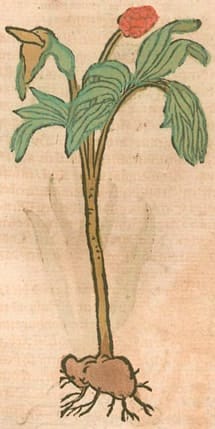 Krauterbuch, Lonitzer, 1578
Krauterbuch, Lonitzer, 1578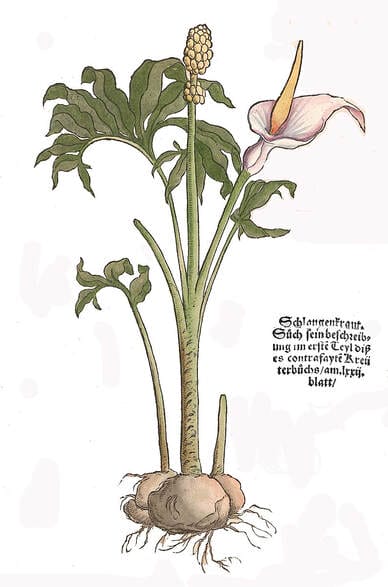 Kreuterbuch, Brunfels, 1537
Kreuterbuch, Brunfels, 1537
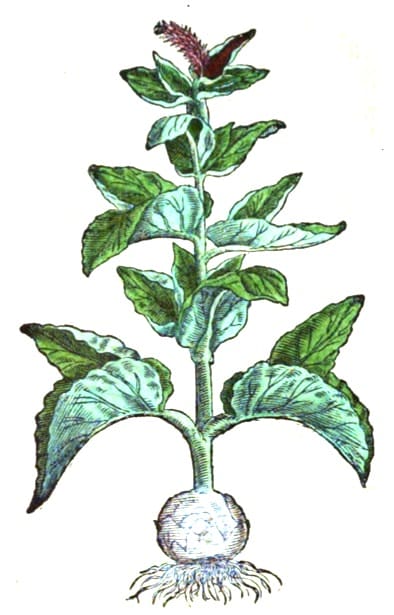
|
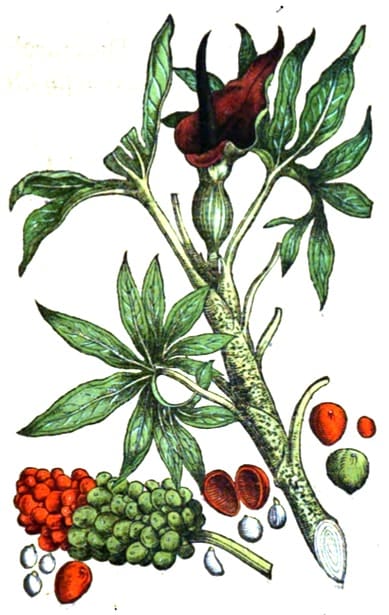
|
(Kreutterbuch, Matthiolus, 1586)
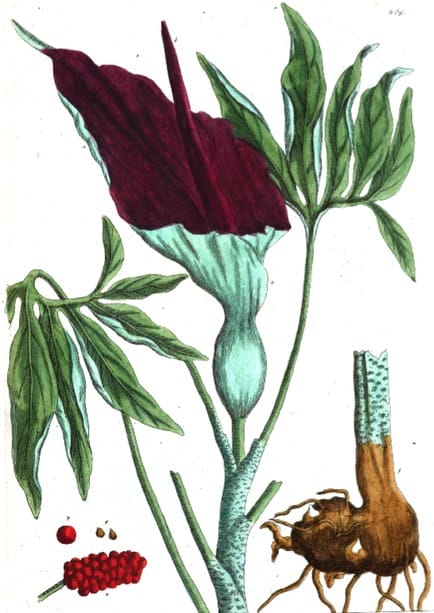
|
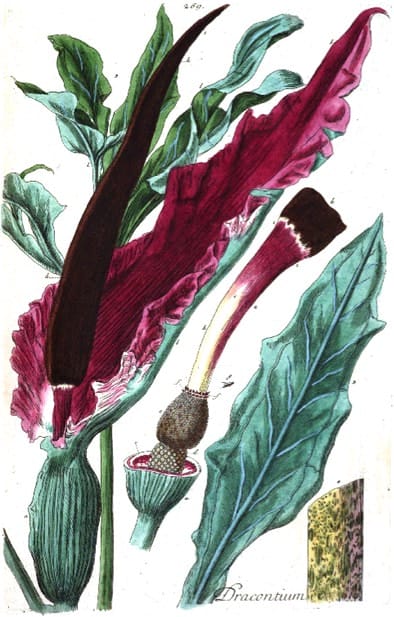
|
Herbarium Blackwellianum, 1757
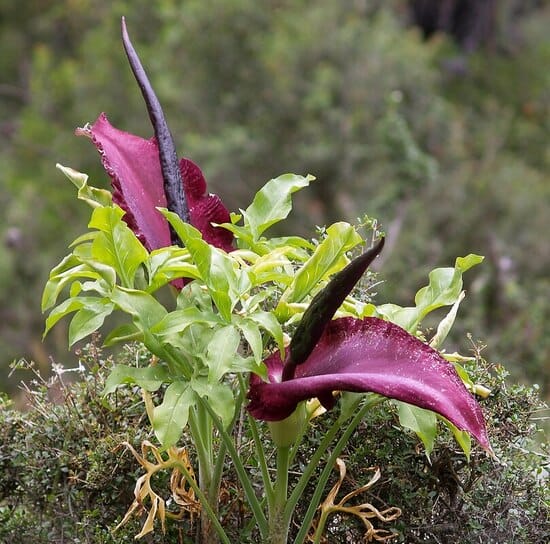 Dracunculus vulgaris
Dracunculus vulgaris(Photo by Jörg Hempel) (Wikimedia)
Botanical name:
Dracunculus vulgaris (syn. Arum dracunculus)
Greater and Lesser types were known.
Dracunculus, also called Dracontium, are closely related to Arums. See Arum for more information on this group.
Parts used:
Root; rarely the Seeds
Temperature & Taste:
Hot, dry. Pungent. Toxic
Uses:
1. Clears Cold-Phlegm:
-Cold-Phlegm conditions
-Coughs, Catarrh, shortness of Breath, difficulty Breathing
-Convulsions caused by Wind-Phlegm
-to easily bring up Phlegm mix the powder with Honey
2. Clears Phlegm, Resolves Masses:
-Scrofula, Lymphatic Swellings
-Cancer (Pliny, Dioscorides, Aetius)
3. Resists Poison:
-Distilled Water of the leaves is good for Plague, Epidemic Fever, Poison and Snake Bite.
4. Strongly Promotes Menstruation, Causes Miscarriage:
-Amenorrhea, Dysmenorrhea (only in strong women)
-Dioscorides said 30 seeds taken in wine and water causes miscarriage
-“Its use as a pressary may also expel the Fetus” (Avicenna)
5. Warms the Kidneys:
-the root roasted, beaten and made into an electuary with Honey ‘provokes Lust exceedingly’. (Salmon)
6. Externally:
-Powdered root mixed with Honey and applied to Sores that are hard to heal
-Root juice has been applied to spots, clouds and films of the Eyes (since Dioscorides)
-fresh leaves are applied to fresh Wounds and Snakes Bites
-Tumors and Cancers
-fruit cures Malignant Ulcers
-fruit consumes Polyps or Noli me tangere in the nose
Dose:
It is expectorant taken with Honey; Diuretic if taken with Wine. (Dioscorides)
Of the PREPARED ROOT in POWDER: 325–650mg (5–10 grains) up to 1 gram (up to 0.5 dram was given against Poison and Plague), 2–3 times daily;
The root powder mixed with twice its weight of Sugar and formed into an Electuary is taken in doses of 1–2 drams.
Comment:
This is related to Arum and Arisaema Tian Nan Xing used in TCM. It is more similar in appearance to the Chinese Tian Nan Xing than the European Arum (Wake Robin). All are used similarly for Cold Phlegm obstruction.
Preparation:
1. Vinegar Prepared Dragon Root:
The root can be prepared as Arum root, notably, by being steeped in Vinegar overnight then dried for use.
2. Wine Prepared Dragon Root:
They can be boiled three times, 15 minutes each time using fresh wine, then dried for use.
3. Roasted Dragon Root:
The root can be roasted in embers until scorched. The roasted root is still warm and dry, but has a milder effect. In addition, it was sometimes used as a warming Kidney tonic.
4. Electuary of the Roasted Root:
The roots can also be roasted in embers, then beaten and formed into an electuary with Honey.
Substitute:
1. Prepared Arum root can be used
2. Arisaema Tian Nan Xing
Main Combinations:
1. Mixed with Bryony root and Honey and applied to chronic, hard to cure and malignant sores, Fistulas and Cancers. (Dioscorides)
2. Gout, Muscular pain, Dragonwort (Arum spp.) is applied with Cow Dung. (Avicenna)
3. Malignant Ulcers, Dragon wort with Bryony in an ointment. (Avicenna)
Cautions:
1. Toxic in overdose
2. Avoid in Pregnancy
3. Avoid in Yin deficiency
Main Preparations used:
Prepared Root, Saline Tincture, Distilled Water of the Leaf, Essence
- Extra Info
-
History
|
‘It is Egypt more particularly that produces the clematis known as the “aron,” of which we have already made some mention when speaking of the bulbs. Respecting this plant and the dracontium, there have been considerable differences of opinion. Some writers, indeed, have maintained that they are identical, and Glaucias has made the only distinction between them in reference to the place of their growth, assuming that the dracontium is nothing else than the aron in a wild state. |
Some persons, again, have called the root “aron,” and the stem of the plant “dracontium” but if the dracontium is the same as the one known to us as the “dracunculus,” it is a different plant altogether; for while the aron has a broad, black, rounded root, and considerably larger,— large enough, indeed, to fill the hand,— the dracunculus has a reddish root of a serpentine form, to which, in fact, it owes its name’. (The Natural History of Pliny, trans. by Bostock and Riley, Vol. 5, 1856) |
